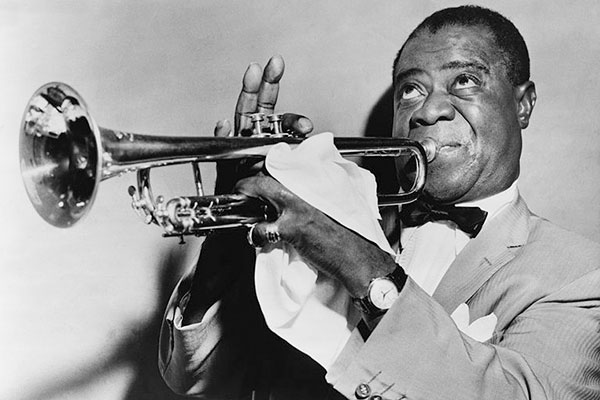Hello Louie: Satchmo and His Horn Ride High Again

Close to the end of his life, Louis Armstrong, the jazz legend, played the swanky Waldorf Astra Hotel, in New York. His appearance there was the culmination of an unbelievable career that took him from a shack in New Orleans, Louisiana, to dizzying heights of fame and fortune. He and his horn, and his always present handkerchief, were his signatures and the thundering applause was his trademark
In this scintillating new one man show, Armstrong, in his dressing room between Waldorf concerts, reminisces about his life and career over the tumult of racial history, rekindling sometimes bitter and sometimes sweet memories. It is an often tender, often biting and always fascinating and provocative show. It stars John Douglas Thompson in a memorable performance as the jazz great.
Satchmo is a play about show business history, but it is a play about American racial history, too, from colored water fountains in Alabama to white only crowds in the North’s ritziest night clubs. It is the always absorbing story of a man and his music, and the ever changing landscape of America that he traveled over in his 70 years.
In the early 1920s, he left the South and went to Chicago to make a name for himself. He hooked up with white manager Joe Glaser, signed contracts with white clubs and even worked in clubs run by gangsters, such as New York’s Dutch Schulz and Chicago’s Al Capone. With his trombone and cornet, he became one of the most famous musicians in the world.
There is a twist to the show. Armstrong often expresses rage that he did not find the love of black audiences and that black performers often called him an “Uncle Tom.” He was a traitor to music, black critics said, because he left the smoke filled barrooms of Louisiana behind in a career that often found him entertaining white audiences. Other black critics said he was wrong to cut number one mainstream hits such as Hello Dolly! and What a Wonderful World. Still others said he never did enough to protest racism.
In Terry Teachout’s remarkable play (Teachout also wrote a biography of Armstrong), Satchmo complained bitterly about this hatred of him by black musicians such as Miles Davis. In the middle of the play, expressing his racial rage, he even said that if he had one hour left in his life, he would like to spend in "choking a white man.”
Armstrong grew up in the World War I era in a neighborhood so tough that it was named the Battlefield. In the early 1920s, he went to Chicago, America’s jazz capital, to join Joe ‘King’ Oliver’s band, one of the best in the nation. The jazz superstar rode a thousand buses and trains, alone and with his band, that crisscrossed the country, to stardom.
He was a superb musician and extraordinary entertainer from the first nights of his long career. He had new arrangements of famous songs and was an innovative performer. He was well known for ‘scat’ singing and playing until the wee hours of the morning. He had a tremendous stage presence with his hoarse voice, wide smile and oversized personality.
The play is long on entertainment history and offers a juicy look at the differences between black and white clubs in the 1930s and the influence of the mob on entertainment.
The strength of the play is its racial history. Armstrong, and all black entertainers, constantly battled it as they drove through the South, playing black and white clubs and using black and white restrooms and separate water fountains. There is a wonderful story about how, after he was famous, he and the musicians he worked with had to go to the back of a white restaurant on the road to get something to eat from the all black wait staff. That night, they might have performed for the people that owned the restaurant.
There is another story, a sad one, about the encounter between Armstrong and his musicians with an aging King Oliver in a southern city. Oliver had become famous and yet lost all of his money. He was destitute when the band met him and they emptied their pockets to help him out.
There is much humor in the play, such as the story about how Satchmo recorded the theme song to Hello Dolly! and then, a few months later, forgot the lyrics and had to have his manager mail them to him on the road.
There is not much on his personal life, a weakness. He was married four times and yet he does not discuss his wives very much.
Despite that, Satchmo at the Waldorf is a titanic look at a towering giant of American entertainment and his times, at our times, and how, over the years, they changed.
The play succeeds because of the masterful performance by John Douglas Thompson. He enters the stage at 70 years of age, barely able to walk, sits down and starts to breathe on an oxygen machine. Thompson has Satchmo’s unique gravelly voice and smile down pat and makes ample use of Armstrong’s famed white handkerchief. I have never seen a one man play in which the performer reminded you so much of the character.
Note: one the way home from the theater, one of the New York radio stations played Armstrong’s What a Wonderful World. I had to smile, even though I was in the middle of a fierce rainstorm.
PRODUCTION: Produced by the Long Wharf Theater, the Shakespeare Company, others. Sets: Lee Savage, Costumes: Ilona Somogyi, Lighting: Kevin Adams, Sound: John Gromada. Directed by Gordon Edelstein. Runs through August 3.